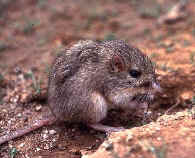Desert pocket mouse facts for kids
Quick facts for kids Desert pocket mouse |
|
|---|---|
 |
|
| Conservation status | |
| Scientific classification | |
| Genus: |
Chaetodipus
|
| Species: |
penicillatus
|
The desert pocket mouse (Chaetodipus penicillatus) is a small rodent that lives in the deserts of North America. You can find it in the southwestern United States and Mexico. This mouse loves sandy, open desert areas with not too many plants.
Contents
What Does the Desert Pocket Mouse Look Like?
The desert pocket mouse is a medium-sized mouse. Adults are usually less than 180 mm long, which is about 7 inches. Their fur is grayish-brown to yellowish-gray. It might also have some black specks. Their fur feels coarse, or rough.
These mice do not have spines on their rump. Instead, they have many long hairs there. These hairs are darker on top and lighter on the sides. Their belly and the underside of their tail are whitish. Their tail has a noticeable crest of fur. It is also longer than their head and body. The average tail length is about 109 mm (4.3 inches). Their hind feet have whitish soles. The average length of a hind foot is 25 mm (1 inch).
Where Do Desert Pocket Mice Live?
The desert pocket mouse lives in the southwestern United States and northern Mexico. Its range goes from southern Nevada down to California and the northern Baja Peninsula. It also reaches into southwestern Colorado. From there, it spreads southeast through Arizona, New Mexico, and southwestern Texas. It also lives in northeastern Mexico.
These mice prefer dry, open desert areas. They like places where plants are spread out. This includes desert washes, shrub areas, and sandy plains. They especially like soft, sandy, or silty soils. You can find them along stream bottoms, desert washes, and valleys. They usually avoid rocky places.
The soils where they live might have plants like creosote bush and palo verde. Other plants include burroweed, mesquite, and cholla cacti. You might also see short, sparse grass. Some areas have yucca, grama grass, and prickly poppy.
How Do Desert Pocket Mice Behave?
Desert pocket mice can be active all year in some places. But in southern Arizona, they are less active in winter. These mice are mostly active at night. They are very solitary, meaning they like to be alone. Each mouse has its own home area, usually less than 1 acre.
Pocket mice can dig burrows even in hard soil. They chew their way through the tough parts. Their burrows are usually in soft, sandy, or gravelly soil. They use these burrows for safety and to store seeds. They also use them to raise their young. A desert pocket mouse usually lives for about one year.
What Do Desert Pocket Mice Eat?
Desert pocket mice look for food under shrubs. They prefer sandy or gravelly soils. They mostly eat seeds from wildflowers, grasses, and shrubs. Sometimes, they also eat green plants and insects.
Scientists have found seeds of mesquite, creosote bush, and broomweed in their cheek pouches. These pouches are like little pockets they use to carry food. They also store seeds in their burrows. They hide seeds in many different spots across their territory. It is believed that these mice get all the water they need from their food.
How Do Desert Pocket Mice Reproduce?
The breeding season for desert pocket mice is in the spring. Female mice can have one or more litters of babies. Each litter usually has two to five young. This happens during the spring and summer.
Pregnancy lasts about 23 days. The babies' front teeth appear about 9 days after birth. Their eyes open around day 14. Their ears also open around day 14 or later. Many young females become pregnant early. They can even have babies while they are still growing their first adult fur. About 95% of the population changes each year.


